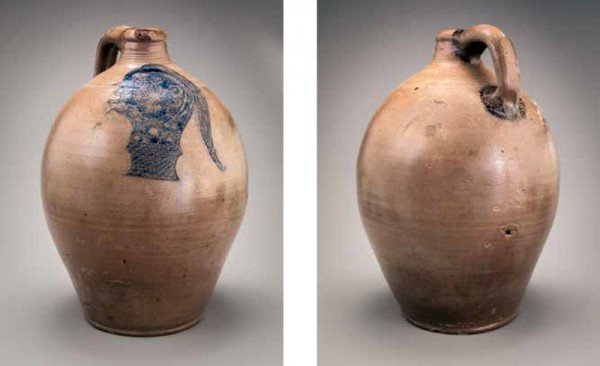
Jug, attributed to the Crolius family, probably John Crolius or John Crolius Jr., New York, New York, ca. 1800–1810. Salt-glazed stoneware. H. 15 1/4". (Private collection; photo, Robert Hunter.)
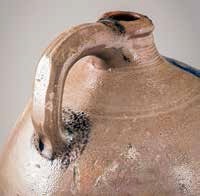
Detail of the handle from the jug illustrated in fig. 1. Note the use of manganese to highlight the handle terminals, and the distinctive thumb dimple used for the lower one.
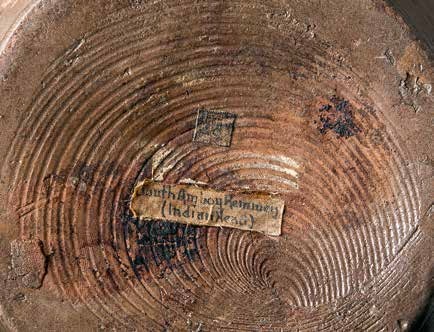
Detail of the bottom of the jug illustrated in fig. 1. The small square patch reads “25”; the larger label reads “South Amboy Remmey / (Indian Head).” Note the distinctive circular marks created when a wire was used to cut the wet jug from the potter’s wheel head.
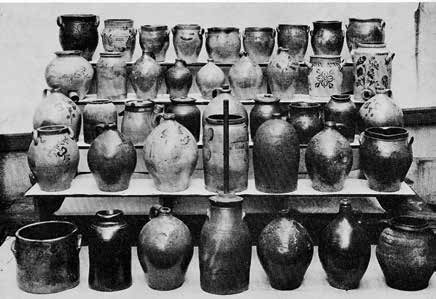
Illustration from W. Oakley Raymond’s article in The Antiquarian 9, no. 6 (January 1928): 41. The red arrow points to the jug, in the front row of the display.
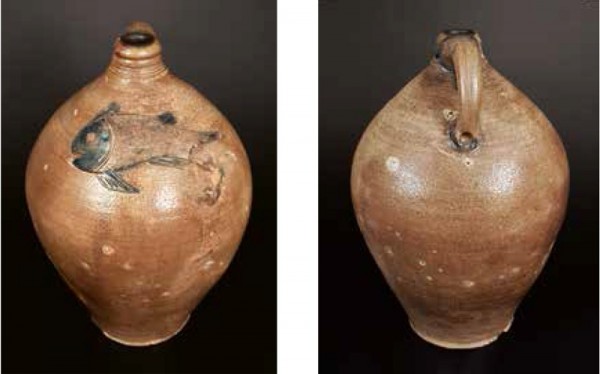
Jug, attributed to John Crolius or John Crolius Jr., New York, New York, ca. 1800–1810. Salt-glazed stoneware. H. 16 1/2". (Courtesy, Crocker Farm.) The jug is now part of the Adam Weitsman stoneware collection at the New York State Museum.

Jug, Clarkson Crolius or John Crolius, New York, New York, 1800–1805. Salt-glazed stoneware. H. 15". (Museum of the City of New York.) The incised scene on the jug commemorates November 25, 1783, when the British forces that had occupied New York City left for good, subsequently, celebrated as Evacuation Day by generations of New York residents.
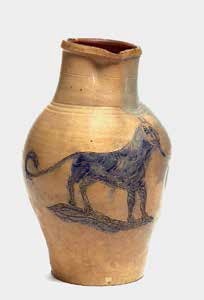
Pitcher, attributed to John Crolius or John Crolius Jr., New York, New York, 1796. Salt-glazed stoneware. H. 14". (Courtesy, The New York State Museum.)
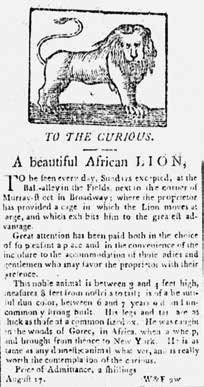
Advertisement, The Minerva & Mercantile Evening Advertiser, August 17, 1796. (Courtesy, New York State Library.) The ad announces the exhibit of an African lion in Manhattan.

Presentation basin, southeastern Pennsylvania (likely Philadelphia), ca. 1730–1760. Trailed slipware. D. 14". (Courtesy, The National Society of The Colonial Dames of America in the Commonwealth of Pennsylvania at Stenton; photo, Gavin Ashworth.)

John Simon (after Jan Verelest), Sa Ga Yeath Qua Pieth Tow, King of the Maquas [Mohawks], ca. 1710. Mezzotint on laid paper. 13 1/2 x 10 1/16". (National Portrait Gallery, Smithsonian Institution.)
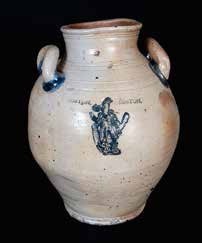
Jar, Jonathan Fenton (1766–1848), Boston, Massachusetts, late eighteenth century. Salt-glazed stoneware. H. 13 3/4". Marks: stamped twice, “BOSTON.” (Courtesy, Crocker Farm.)
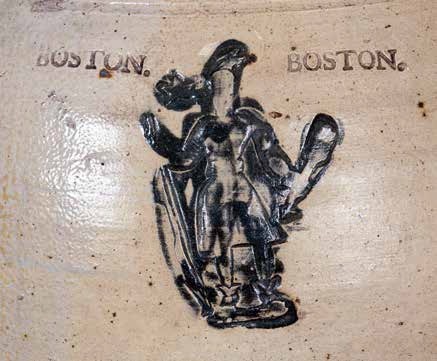
Detail of the Native American figure on the jar illustrated in fig. 11.
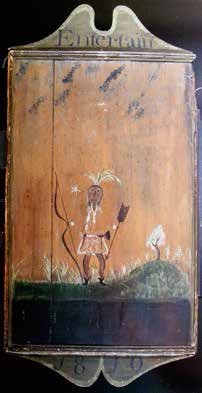
Tavern sign, Rehoboth, Massachusetts, ca. 1810. Wood and iron. (Collection of Leslie and Peter Warwick; photo by Williamstown Art Conservation Center.) This image of a Native American is similar to one on the Massachusetts
state seal.

Detail of the Native American profile incised on the jug illustrated in fig. 1.
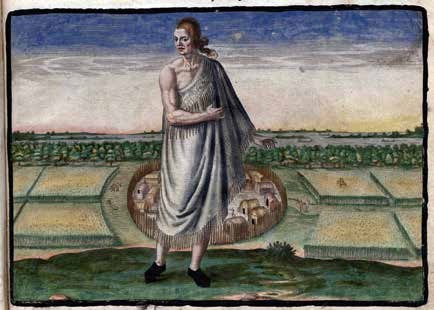
Theodor de Bry (1528–1598), after John White (fi. 1585–93), An Ageed Manne in His Winter Garment, Frankfurt, Germany, 1590. Hand-colored engraving on laid paper. 6 1/8 x 8 11/16". (Library, University of North Carolina at Chapel Hill.)
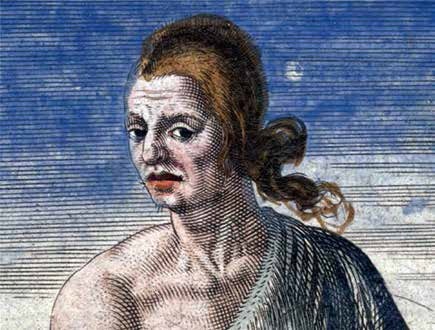
Detail of the “Ageed Manne” illustrated in fig. 15 showing the facial hair on the chin and upper lip.
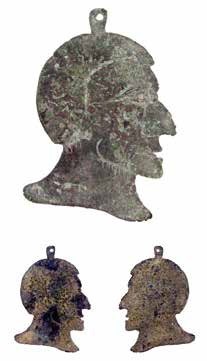
Badge or pendant, Jamestown, Virginia, ca. 1607–1617. Copper alloy. (Courtesy, Jamestown Rediscovery Foundation [Preservation Virginia]; photo, Michael Lavin/Jamie May.) Discovered in a ca. 1607–1617 cellar in James Fort, this object appears to represent Chief Powhatan (Wahunsonacock).
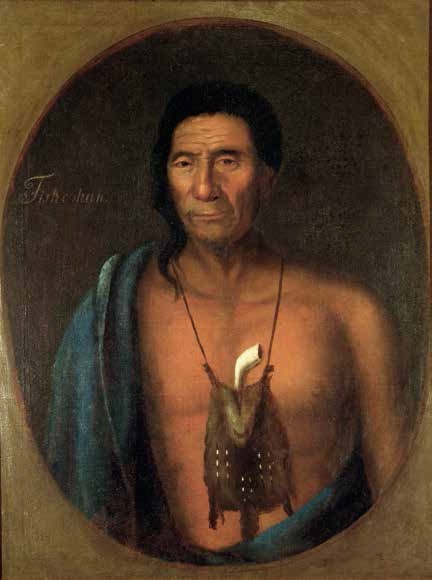
Gustavus Hesselius (1682–1755), Tishcohan, ca. 1735. Oil on canvas. 33 x 25". (Philadelphia History Museum, Historical Society of Pennsylvania Collection, Gift of Granville Penn.)
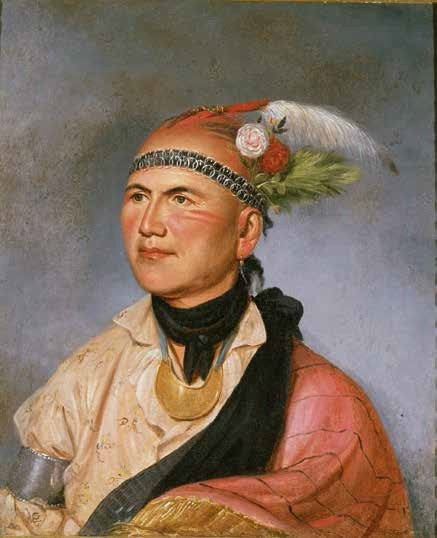
Charles Willson Peale (1741–1827), Joseph Brant/Thayendanegea (1742–1807), ca. 1797. Oil on canvas. 25 1/2 x 21 3/8". (Courtesy of Independence National Historical Park, Philadelphia.) This portrait was made by Peale during a diplomatic visit to Philadelphia by Brant and other Native leaders. The floral headdress and absence of weapons indicates a mission of peace.
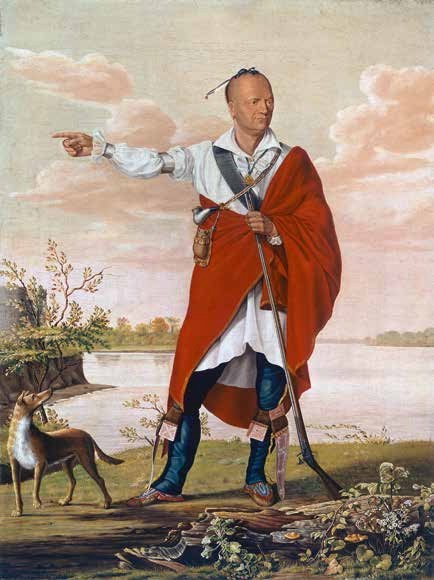
William Berczy (1744–1813), Thayendanegea (Joseph Brant), ca. 1807. Oil on canvas. 24 5/16 x 18 1/8". (National Gallery of Canada.) This imagined portrait set in a bucolic landscape was inspired by Brant’s death in 1807.
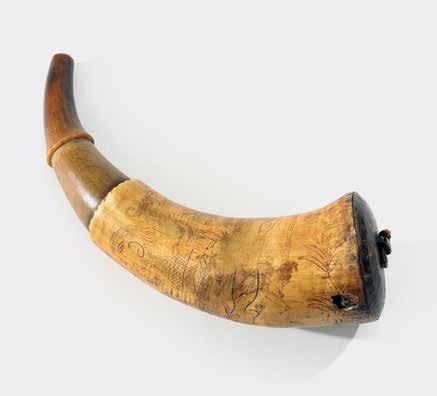
Powder horn that belonged to Joseph Brant (Thayendanegea), ca. 1790. Cow horn, wood, and iron. L. 8". (Courtesy, Joseph Brant Museum, 2003.13.1.) Brant is thought to have used this powder horn during the latter part of the 1700s. The horn is engraved with decoration of various wildlife including birds, fish, a deer, a turtle, beaver, porcupine, and two indigenous heads.

Detail of one of the Native American profiles on the powder horn illustrated in fig. 21.

Artist drawings comparing the incised lines on portraits on
the Manhattan stoneware jug on the left and the Joseph Brant powder horn on the right. (Drawings, Oliver Mueller-Heubach.) The stylized effect of the incising technique is evident on the outcome of both portraits. The facial hair on both men is clearly and carefully delineated with in the incising. It is interesting that the technique of cross-hatching is used on the lower neck and chest area. The constriction on the lower neck of the stoneware portrait, however, might correspond to a neck cloth or stock as seen in the portrait illustrated in fig. 24.
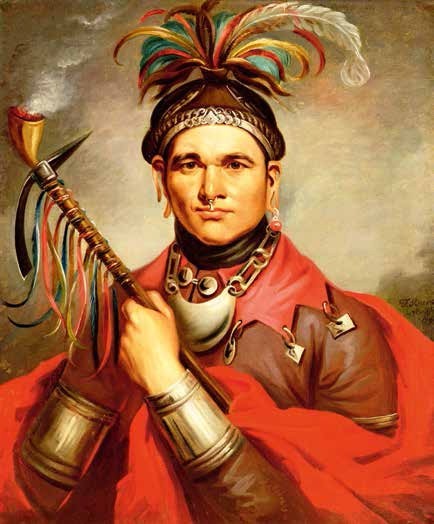
Frederick Bartoli, Ki On Twog Ky (also known as Cornplanter), 1732/40–1836, 1796. Oil on canvas. 30 x 25". (Courtesy, New-York Historical Society, Gift of Thomas Jefferson Bryan.) This bust-length portrait shows Cornplanter’s cut earlobes and the accoutrements of the ranking chief of the Seneca tribe. Note the neckcloth, or stock, a fashionable device among American and European gentlemen that was also restrictive and uncomfortable.

Charles Balthazar Julien Févret de Saint-Mémin (1770–1852), Unidentified Osage (Chief of the Little Osage), 1804. Charcoal with stumping, black pastel, black and white chalk, Conté crayon over graphite on pink prepared paper, nailed over canvas to a wooden strainer. 22 3/4 x 16 3/4". (The New-York Historical Society, 1860.93.) The subject of this portrait was one of five Osage chiefs invited by President Jefferson to Washington in 1806.

John Vanderlyn (1775–1852), The Murder of Jane McCrea, 1804. Oil on canvas. 32 1/2 x 26 1/2". (Wadsworth Atheneum Museum of Art, 1855.4.)

Storage jar, Charles W. Braun, Buffalo, New York, ca. 1890. Salt-glazed stoneware. H. 10". (Courtesy, The New York State Museum.) Depicted in brushed cobalt, this Native American figure was inspired by Buffalo Bill’s Wild West show. Taken from one of the scenes of Indian raids that were part of the show, the “Indian” is shouting “Hold him.”

Jug, attributed to New York State, ca. 1875. Salt-glazed stoneware. H. not given. (Courtesy, Crocker Farm.)

Trench-art artillery shell, American, ca. 1917–1919. Carved brass. H. 13 3/4". (Private collection; photo, Robert Hunter.) Inscribed “28th / SQUADRON.” The 28th Aero Squadron was an Air Service unit of the United States Army that fought on the Western Front during World War I. A Native American warrior was used as their insignia, and is still in use today by the 28th Bomb Squadron of the United States Air Force.

Detail of the carved artillery shell illustrated in fig. 29.
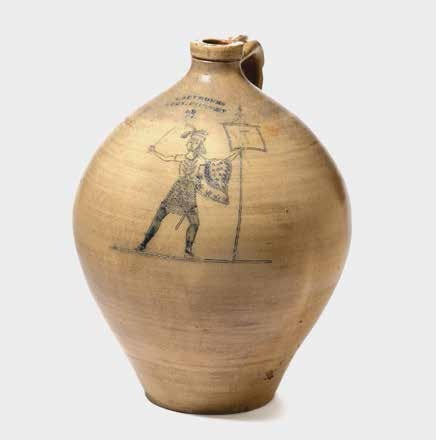
Jug, Israel Seymour (1784–1852), Troy, New York, ca. 1815. Salt-glazed stoneware. H. 14". (Courtesy, The New York State Museum.) The elaborately incised figure represents the Seneca chief and prophet Handsome Lake.
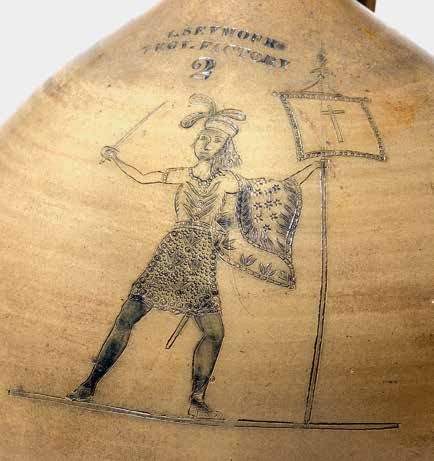
Detail of the incised figure on the jug illustrated in fig. 31.
